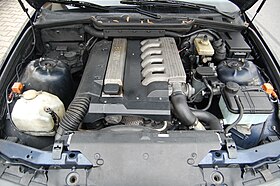BMW M51
| BMW M51 | |
|---|---|
 | |
| Overview | |
| Manufacturer | BMW |
| Production | 1991-2000 |
| Layout | |
| Configuration | Inline-6 |
| Displacement | 2.5 L; 152.4 cu in (2,497 cc) |
| Cylinder bore | 80 mm (3.15 in) |
| Piston stroke | 82.8 mm (3.26 in) |
| Cylinder block material | Cast iron |
| Valvetrain | SOHC 2 valves x cyl. |
| Compression ratio | 22.0:1 |
| Combustion | |
| Turbocharger | Single turbo, tds-engines also have an intercooler |
| Fuel system | Swirl-chamber-injection |
| Management | Bosch DDE 2.1 |
| Fuel type | Diesel fuel (DIN 51601) |
| Cooling system | Water-cooled |
| Output | |
| Power output | 85–105 kW (116–143 PS) |
| Torque output | 222–280 N⋅m (164–207 lb⋅ft) |
| Dimensions | |
| Dry weight | 132 kg (291 lb) |
| Chronology | |
| Predecessor | BMW M21 |
| Successor | BMW M57 |
The BMW M51 is an inline-6 cylinder Diesel engine produced by the upper austrian BMW plant in Steyr from July 1991 through February 2000. Its predecessor is the BMW M21, the successor is the BMW M57.
Description
The M51 is a water-cooled and turbocharged inline six-cylinder diesel engine with a Bosch VP20-swirl-chamber-injection.[1][2] The displacement is 2.5 L; 152.4 cu in (2,497 cc) and the compression ratio is 22.0:1.
Some engine variants have an intercooler in addition to the turbocharger, they can be identified by the tds.[2] The M51 is an engine made of cast iron, it has one chain driven overhead camshaft[3] and two valves per cylinder.[2][3] Compared to the M21 the M51 now has tappets and a hydraulic valve lash adjustment.[2] The fuel injection in the first engines is controlled by the ECU Bosch DDE 2.1, which was replaced after the first technical revision by the DDE 2.2.[3] This results in greater torque at lower revs.[3] For lubrication SAE 5W-40 oil is used.[4]
| Engine | Power output | Torque | Year |
|---|---|---|---|
| M51D25 UL | 85 kW (116 PS) @ 4800 rpm | 222 N⋅m (164 lb⋅ft) @ 1900 rpm | 1991–1997 |
| M51D25 OL | 105 kW (143 PS) @ 4800 rpm | 260 N⋅m (192 lb⋅ft) @ 2200 rpm | 1991–1996 |
| X25DT[5][A 1] | 96 kW (131 PS) @ 4800 rpm | 250 N⋅m (184 lb⋅ft) @ 1400 rpm | 1994–2001 |
| M51D25TÜ UL[3] | 85 kW (116 PS) @ 4800 rpm | 230 N⋅m (170 lb⋅ft) @ 1900 rpm | 1996–1998 |
| M51D25TÜ OL[3] | 105 kW (143 PS) @ 4800 rpm | 280 N⋅m (207 lb⋅ft) @ 2200 rpm | |
| M51D25TÜ OL[3] | 105 kW (143 PS) @ 4600 rpm | 1998–2000 | |
| M51D25M1[6][A 2] | 100 kW (136 PS) @ 4400 rpm | 270 N⋅m (199 lb⋅ft) @ ? rpm | until 1999 |
Applications:
- 1991-1996 E36 325td (M51D25 UL)
- 1996-1998 E36 325td (M51D25TU UL)
- 1993-1996 E36 325tds (M51D25 OL)
- 1996-1998 E36 325tds (M51D25TU OL)
- 1992-1996 E34 525td (M51D25 UL)
- 1991-1996 E34 525tds (M51D25 OL)
- 1996-2000 E39 525tds (M51D25TU OL)
- 1996-2000 E39 525td (M51D25TU UL)
- 1996-2000 E38 725tds (M51D25TU OL)
- 1995-2001 Land Rover Range Rover 2.5 D/DSE
- 1995-2001 Opel Omega
- 1992 UMM Alter II (Very rare model only one was made, the car was made in Portugal with the engine, gearbox and electronics being made and fitted in at BMW's Munich plant)
See also
External links
- The UnixNerd's BMW M51 engine page with photos, history and common problems.
References
- ^ BMW E38 7 Series 725 tds Technical data
- ^ a b c d Die BMW-Sportdiesel: Von 524td E28 über 530d E39 bis BMW M550d F10 (german)
- ^ a b c d e f g Etzold: So wird's gemacht: pflegen – warten – reparieren. Band 102, BMW 5er E39 Delius Klasing Verlag. Pages 12 and 13 (german)
- ^ Übersicht der Motorölqualitäten. Page 7 (german)
- ^ Opel Omega B 2.5 TD 96 kW 130 PS - Motor: 25DT, X25DT, X25TD - Eco Optimierung / Leistungssteigerung (german)
- ^ Automobile Catalogue: 1997 Range Rover 2.5 DSE (model for Europe ) specifications & performance data review.
